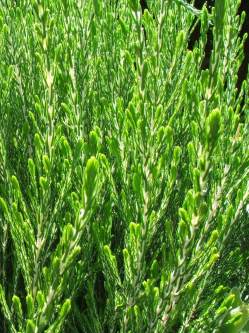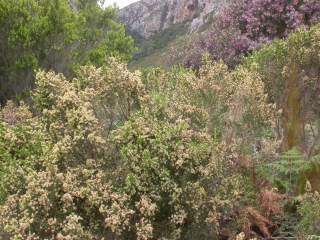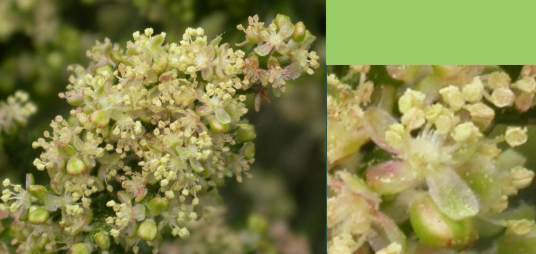Passerina corymbosa
Passerina corymbosa Eckl. ex C.H.Wright
Family: Thymelaeaceae
Common names: gonna bush (Eng.); gonnabos, bakkerbos (Afr.)
Introduction
Passerina corymbosa, a medium to tall shrub covered in masses of small creamy flowers, is fast-growing and would be a welcome addition to any fynbos garden.
Description
Description
Passerina corymbosa is the most frequently encountered species in the genus Passerina and varies in height from 1-3 m. The stems, which are made up of extremely tough fibres, are not easy to break and the bark peels off in long, tough strips. A definite distinguishing feature is the young white stems which are partially covered with tiny, linear leaves about 5 mm long. The normal green, linear leaves have a hairy groove beneath and are 3-10 mm long.

The insignificant small flowers, which are dull cream or reddish, are borne in large numbers in the axils of the leaves. However, during the flowering period, from August to November, the red sepals and large yellow anthers are quite showy. (It is advisable to use a hand lens to observe this magical phenomenon.)
The stamens and exserted anthers, which appear on the long filaments, are attached to the top of the calyx tube. The coloured calyx is inflated below, with four lobes above. There are no petals present.
Conservation Status
Status
This widespread shrub is not endangered or vulnerable. It has a status of Least Concern.
Distribution and habitat
Distribution description
Passerina corymbosa usually occurs on slopes and sandy flats where it grows amongst dry and asteraceous fynbos. It occurs from Tulbagh in the Western Cape to Port Elizabeth in the Eastern Cape, with an altitude variation of 20-1850 m.
Here, this fine-leaved, ericoid shrub grows on some of the driest fynbos patches, and its ability to extract soil moisture from deep underground enables it to survive harsh conditions.
The gonna bush, by which it is more commonly known, also grows on the lowlands where dry fynbos, renosterveld and succulent karoo merge, with soil types ranging from colluvial (or shallow litho soils derived from quartzite), calcareous dunes on coastal forelands, to shales and sil-ferricretes. In mountainous areas this shrub grows well in soil depths of at least 40 cm. Annual rainfall throughout its distribution varies from 450-950 mm.

Derivation of name and historical aspects
History
The genus name Passerina was given by the great Carl Linnaeus. The genus Passer consists of the passerine group of birds, to which sparrows belong. Passer- presumably refers to a sparrow, while -ina relates to the black seeds which resemble a sparrow's beak. The species name corymbosa, meaning a cluster, is derived from the Greek word korumbos, which may refer to the inflorescence being a corymb, which is a raceme with the lower flower stalks longer than those above. This feature enables all the flowers to be on the same level. Two other passerinas included in this series are P. ericoides and P. filiformis subsp. filiformis.
Other genera in the family include Dais, Gnidia, Struthiola and Lachnaea, several of which have also been described on this site.
Ecology
Ecology
Passerina corymbosa is a pioneer species with a short juvenile period. It also has a high seed output and quite large seedbanks. This relatively short-lived species also shows high levels of senescence and mortality in a 10-15-year-old veld.
The gonna bush, with its dry fruit, is wind-pollinated like all other species in the genus. Exserted anthers normally release large amounts of pollen. These light, rounded pollen grains are then easily carried by the wind.
In fynbos terms this ericoid shrub is regarded as a seeder - a plant which is killed during a fire and then depends on seed for regeneration. Seeds are mainly shed in late summer, with most of it decaying when buried in the veld for more than a year.
In areas of high rainfall it is widespread on coastal dunes due to the fact that the young sandy soil might not be well consolidated and has poor moisture retention. The gonna bush contributes to the forming of a mutualistic relationship through its root system which has the ability to stabilise sandy soils.
Fire is an integral part of fynbos and helps shape the vegetation occurring in the Cape Region. In the long run, this phenomenon contributes towards the creation of a niche for ephemerals (plants which grow, bloom and quickly shed seed just a few years after the fire). It also gives a new lease on life to seeders (which eventually become senescent when there is no fire) and resprouters.
Uses
Use
Passerina corymbosa, like most other taxa in this genus, was used to heat up ovens. When set alight, a tremendous blaze was produced which rapidly heated the oven. Due to its tough stems, the bakkerbos was also very effective in tying down thatch.
Khoi people are said to have used certain Passerina species as cordage for the purpose of tying together poles for huts, and also plaited it into twine and thongs for whips.
This plant plays a vital role in anchoring the sandy soils of coastal dunes, and their removal can cause significant erosion. It is also useful as a filler in floral displays.
Growing Passerina corymbosa
Grow
Sow the relatively fresh seed during autumn using a well-drained medium such as coarse river sand. Slightly level the medium, gently scatter seed, and cover lightly with sand or bark. Water lightly and keep moist. Seeds germinate readily. (Leonard Jacobs, pers. comm. 2006). In order to enhance germination, smoke-treat the seed using Kirstenbosch Seed Primer.
Once germinated, treat seedlings with diluted liquid fertiliser, as this will strengthen the root system. Do this at regular intervals, once every second week.
When ready to pot, start applying liquid fertiliser at the recommended rate. After potting, a granular organic fertiliser can be introduced.
The ideal time for planting in the Western Cape is autumn to early winter, but planting can also be done during the rest of the year in the Eastern Cape.
Planting during the correct time of the year gives the plant a better chance to establish itself before the onset of a harsh spring/summer. Prepare the soil before planting by adding compost and organic fertiliser. This will improve water retention and soil texture. After planting, water well and cover with a fine layer of mulch or compost which will help to keep the soil cool. Although this shrub naturally occurs in nutrient-deprived soil, it is recommendable to fertilise the planted area at least twice a year.
It is best used in small groupings and en masse for the small to larger garden respectively.
This shrub, which is also very effective in any water-wise garden set-up, also grows well with other shrubs such as Berzelia lanuginosa, Restio dispar, Chondropetalum tectorum, Pelargonium cucullatum, Metalasia muricata, Protea neriifolia, P. compacta, Hymenolepis parviflora, Chrysanthemoides monilifera, Athanasia crithmifolia, Leucospermum conocarpodendron and Leucadendron gandogeri.
Larger to small groundcovers that complement it well are Senecio halimifolius, Helichrysum cymosum, H. dasyanthum, Plechostachys serpyllifolia, Leucospermum oleifolium, Carpobrotus edulis, C. acanaciformis and Pelargonium capitatum.
References
- Bean, A. & Johns, A. 2005. Stellenbosch to Hermanus. South African Wild Flower Guide 5. Botanical Society of South Africa, Cape Town.
- Cowling, R. 1992. Ecology of fynbos. The nutrients, fire and diversity. Oxford University Press, Cape Town.
- Cowling, R. & Richardson, D. 1995. Fynbos: South Africa 's unique floral kingdom. Fernwood Press, Vlaeberg, Cape Town.
- Cowling, R.M., Le Matre, D.C., Mckenzie, B., Prys-Jones, R.P. & Van Wilgen, B.W. 1987. Disturbances and the dynamics of fynbos biome communities. South African National Scientific Programmes Report No. 135. CSIR, Pretoria.
- Dyer, R.A. 1975. Genera of southern African flowering plants, vol. 1. Dicotyledons. National Botanical Institute, Pretoria.
- Jackson, W.P.U. 1980. Wild flowers of the fairest Cape. Howard Timmens, Cape Town.
- Jackson, W.P.U. 1990. Origins and meanings of names of South African genera. University of Cape Town Ecolab, Cape Town.
- Trinder-Smith, T. 2003. Levy's guide to the plant genera of the southwestern Cape. Bolus Herbarium ( University of Cape Town ) Cape Town.
- Usher, G. 1974. Dictionary of plants used by Man. Constable, London.
- Usher, G. 1979. Dictionary of botany, edn 4. Redwood Burn, London.
- Van Wyk, B-E. & Gericke, N. 2000. People's plants. A guide to useful plants of southern Africa. Briza Publications, Pretoria.
Credits
Roger Oliver
Kirstenbosch
November 2006
Plant Attributes:
Plant Type: Shrub
SA Distribution: Eastern Cape, Western Cape
Soil type: Sandy, Clay, Loam
Flowering season: Spring, Early Summer, Winter
PH: Neutral
Flower colour: Red, Cream
Aspect: Full Sun
Gardening skill: Easy
Special Features:
Horticultural zones










Rate this article
Article well written and informative
Rate this plant
Is this an interesting plant?
Login to add your Comment
Back to topNot registered yet? Click here to register.